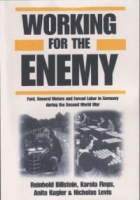| Working For The Enemy: Ford, General Motors, And Forced Labor In Germany During The Second World War артикул 13329d. |
 |
Book DescriptionWorking for the Enemy General Motors, the largest corporation on earth today, has been the owner since 1929 of Adam Opel AG, Russelsheim, the maker of Opel cars Ford Motor Company in 1931 built the Ford Werke factory in Cologne, today the headquarters of European Ford In this book, historians tell the astonishing story of what happened озопж at Opel and Ford Werke under the Third Reich, and of the aftermath today Long before the Second World War, key American executives at Fordand General Motors were eager to do business with Nazi Germany Ford Werke and Opel became indispensable suppliers to the German armed forces, together providing most of the trucks that later motorized the Nazi attempt to conquer Europe After the outbreak of war in 1939, Opel converted its largest factory to warplane parts production Both companies set up extensive maintenance and repair networks to help keep the war machine on wheels During the first two years of the war, General Motors andFord executives from the United States negotiated with the Nazi leadership the terms under which their German factories were converted to their wartime functions James Mooney, the leading GM executive in Europe, met with Hitler, Roosevelt and British diplomats in the months from October 1939 to March 1940 in the hope of mediating a peace that would have been favorable to Germany Mooney was a recipient of the Order of the Golden Eagle, the highest Nazi honor for foreigners Mooney shared that last distinction with Henry Ford, the founder of Ford Motor Company, whose anti-Semitic writings in The International Jew (1921) were translated into many languages at his own expense and served as an inspiration to Hitler's Mein Kampf (1924) German FordWerke and Opel executives were integrated into the highest levels of the Third Reich's wartime production planning As the war wore on and production became the highest homefront priority, they and their fellow corporate managers took an increasingly important role at the Reich Armaments Ministry Contact between the German subsidiaries and the U S mother corporations continued up until the outbreak of war between the United States and Germany in December 1941, and there is ample evidence of subsequent communications During the war, the Nazi Reich used millions of POWs, civilians from German-occupied countries, and concentration camp prisoners as forced laborers in the German homefront economy In the absence of millions of German men who had been sent to the front, forced labor became indispensible to German war production and agriculture As of August 1944, the high point of Nazi forced-labor programs, 8 million foreigners were being used as forced laborers within the borders of the Reich The largest groups consisted of civilians rounded up from the occupied territories of the Soviet Union (mostly young women) and Poland as well as in the West, POWs from France, Poland, the Soviet Union and other countries, and Jewish and other laborers provided by the concentration camps in "work-to-death" programs Starting already in 1940, Ford Werke and Opel also made use of thousands of forced laborers POWs and civilian detainees, deported to Germany by the Nazi authorities, were kept at private camps owned and managed by the companies In the longest section of the book, ten people who were forced to work at Ford Werke recall their wartime experiences in oral testimonies Their story is vivid and moving For more than fifty years, legaland political obstacles frustrated efforts to gain compensation for Nazi-era forced labor The book briefly reviews that history In 1998, former forced laborers filed dozens of class action lawsuits against German corporations in U S courts The first lawsuit was filed against Ford Motor Company and Ford Werke AG, and General Motors was also sued in a wave of litigation that hit nearly every major German corporation, from Volkswagen and Daimler-Benz to Siemens and Bosch This was accompanied by a wave of German labor court cases demanding compensation for Nazi-era forced labor, and served to revive controversy over the still-unpaid compensations The book's concluding chapter reviews the subsequent, immensely complex negotiations towards a settlement - which involved Germany, the United States, Poland, Russia, Ukraine, Belarus, Czech Republic, Israel and several other countries, as well as dozens of well-known German corporations. Рассматриваются2004 г ISBN 1845450132. |